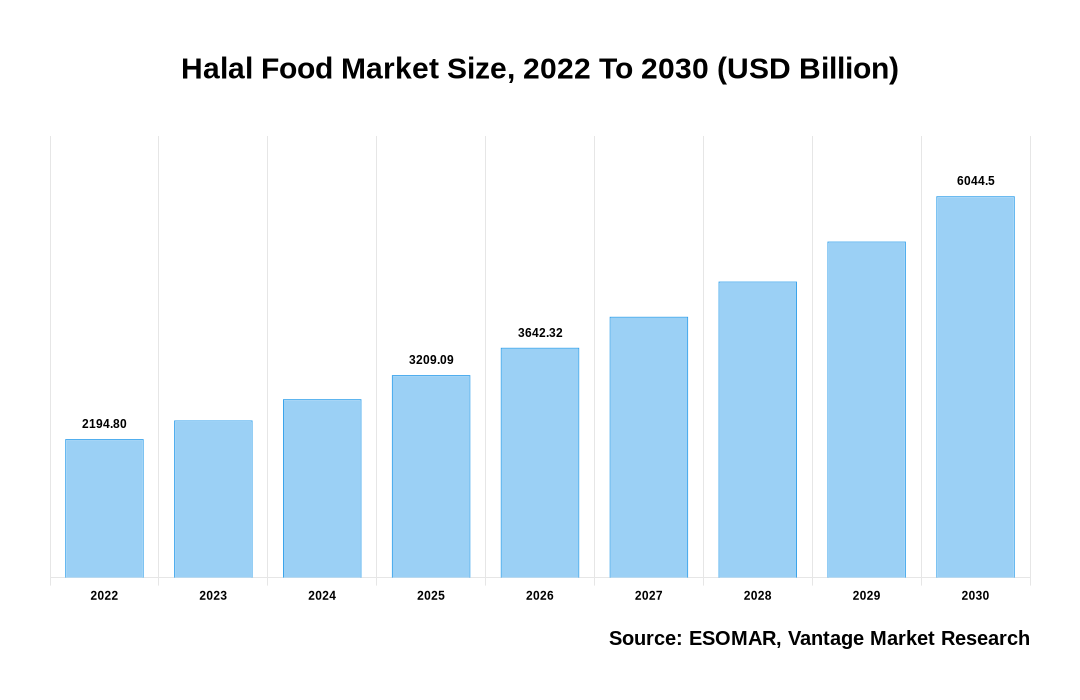Global Halal Food Market
As stated in our extensive report; the Global Halal Food Market accounted for USD 2194.8 Billion in 2022 and is projected to reach a value of USD 6044.5 Billion by 2030.
The Halal Food market has witnessed significant growth in recent years as the demand for Halal-certified products continues to increase globally. The increasing number of Muslims, the increased public knowledge of the dietary rules for Halal Food, and the expansion of Halal certification services contribute to this growth. In 2030, there will be 2.2 billion Muslims worldwide, according to a Pew Research Center estimate. This growth in the Muslim population has resulted in a higher demand for Halal Food products, as these products are prepared and manufactured under Islamic dietary laws. Muslims are required to consume Halal Food, which is permissible and considered lawful in Islam, and this has fuelled the demand for Halal-certified products.
Furthermore, the Halal Food market has grown significantly due to the proliferation of Halal certification services. For a product to be considered Halal, it must undergo a certification process conducted by recognized Halal certification bodies. These certification bodies ensure that the production and preparation of the food adhere to the strict Islamic dietary laws. Over the years, there has been an increase in the number of Halal certification agencies and organizations operating globally, making it easier for manufacturers and businesses to obtain Halal certification for their products. This has boosted consumer confidence in Halal products and facilitated the international trade of Halal goods.
Click To Get a Free Sample On the Research Study

Key Factors Influencing Global Halal Food Market Growth
The growth of the global Halal Food market can be attributable to the following:
- There is a growing awareness among Muslims about the importance of consuming Halal Food products. More people are seeking certified halal products, leading to increased demand in the market.
- The globalization of the food industry has resulted in increased availability and accessibility of Halal Food products. This has led to a more significant consumer base, with non-Muslims also choosing Halal Food due to its perceived quality and safety.
- Many governments worldwide have implemented regulations and support initiatives to encourage the development of the Halal Food industry. This includes certifications, labelling laws, and financial incentives, which have helped spur growth in the market.
- The Halal Food market is witnessing a wave of product innovation and diversification. Companies are introducing new and convenient Halal Food options, including ready-to-eat meals, snacks, and beverages, to cater to the changing consumer preferences.
- Increasing disposable incomes, particularly in emerging markets, drive the demand for higher-quality and healthier food options. Halal Food, perceived as more nutritious and cleaner, is becoming a preferred choice for many consumers.
- The rise in halal tourism, where Muslims travel to explore new destinations while adhering to halal practices, also boosts the demand for Halal Food. Hotels, restaurants, and food service providers are adapting to cater to this niche market segment.
Asia Pacific Region to Express the Largest Market Growth
Asia Pacific is accounted to have the most significant market growth in 2022. The growing Muslim population in this region is driven in part by migration from Muslim-dominated nations to other areas. As the number of Muslims increases, there is a higher demand for Muslim-friendly food, and this trend is expected to continue, thereby boosting the market in this region. According to a Pew Research Centre article from April 2019, India is projected to have an 11.1% Muslim population by 2060. The Muslim population’s rapid growth and psychological development will drive the market during the forecast period.
The European market is expected to increase at the second-fastest compound annual growth rate (CAGR) over the projected time frame. The increasing popularity of certified products in the region drives consumer awareness and contributes to the market’s growth. For example, in 2020, O’Tacos, a fast-food chain from France, introduced halal-certified French-style meat and vegetable wraps in Italy. Additionally, there are approximately 500 manufacturers in Italy, ranging from small to large-sized, that have obtained halal certification. As a result of these trends and the introduction of newly certified products, the market in the region is anticipated to experience a significant upward growth trajectory.
Conclusion
In conclusion, several factors, such as the growing Muslim population, increased awareness of the dietary criteria for Halal Food, and the development of Halal certification services, have contributed to the rise of the Halal Food business. The demand for Halal-certified products is fuelled by the Muslim population and non-Muslim consumers who perceive Halal Food as healthier, more ethical, and of higher quality. The growth of the Halal Food market is expected to continue in the coming years as more countries and companies recognize the potential of this lucrative market segment.
Some of the key players in the Global Halal Food Market include QL Foods Sdn Bhd (Malaysia), Al Islami Foods Co. (UAE), DagangHalal Group (Malaysia), Saffron Road (U.S.), Kawan Foods Berhad (Malaysia), Janan Meat Ltd. (UK), Prima Agri-Products Sdn Bhd (Malaysia), Cargill Inc. (U.S.), BRF S.A. (Brazil) and others.
![[Market Research Reports] – Research Google News Blog | VMR.Biz](https://www.vmr.biz/wp-content/uploads/2022/12/logo-removebg-preview.png)











